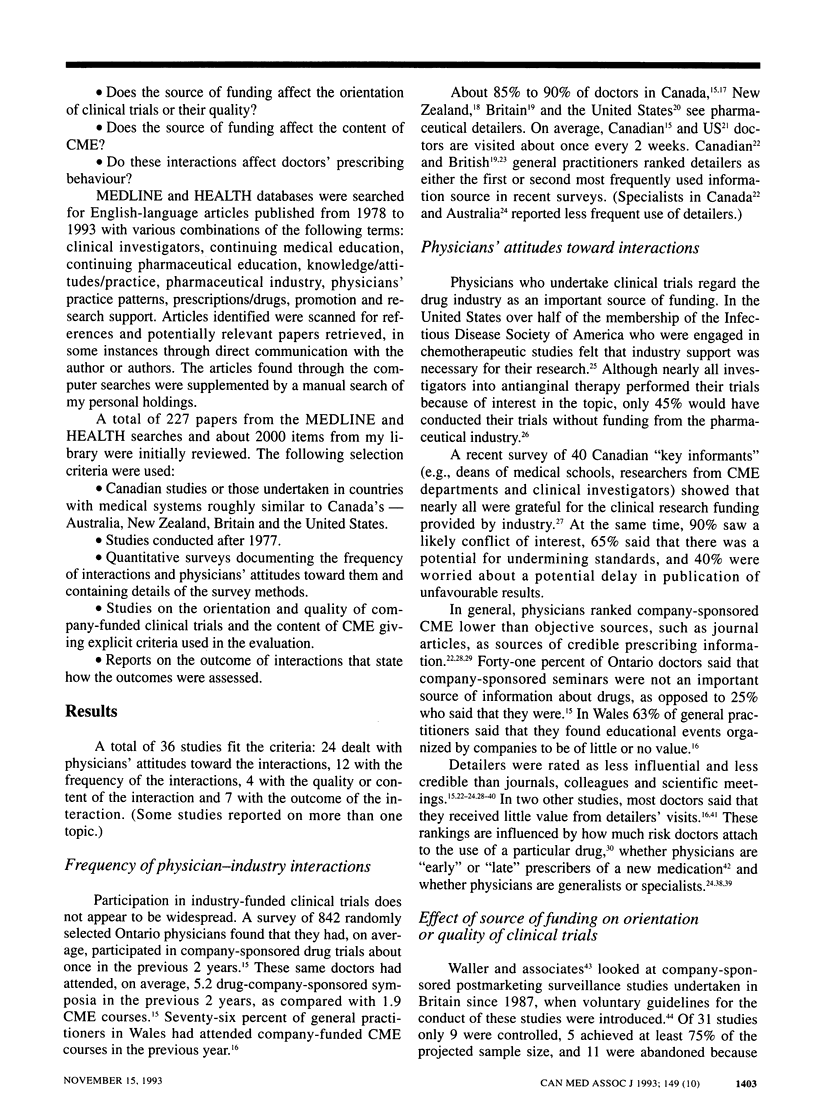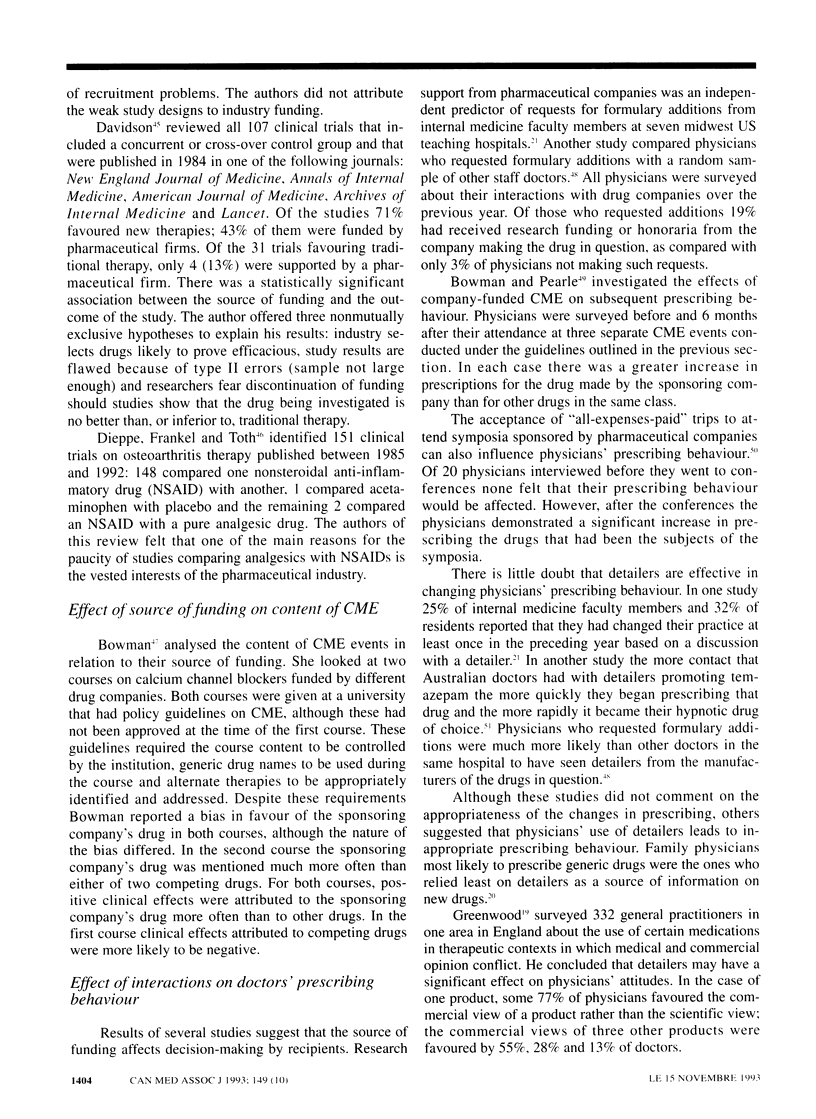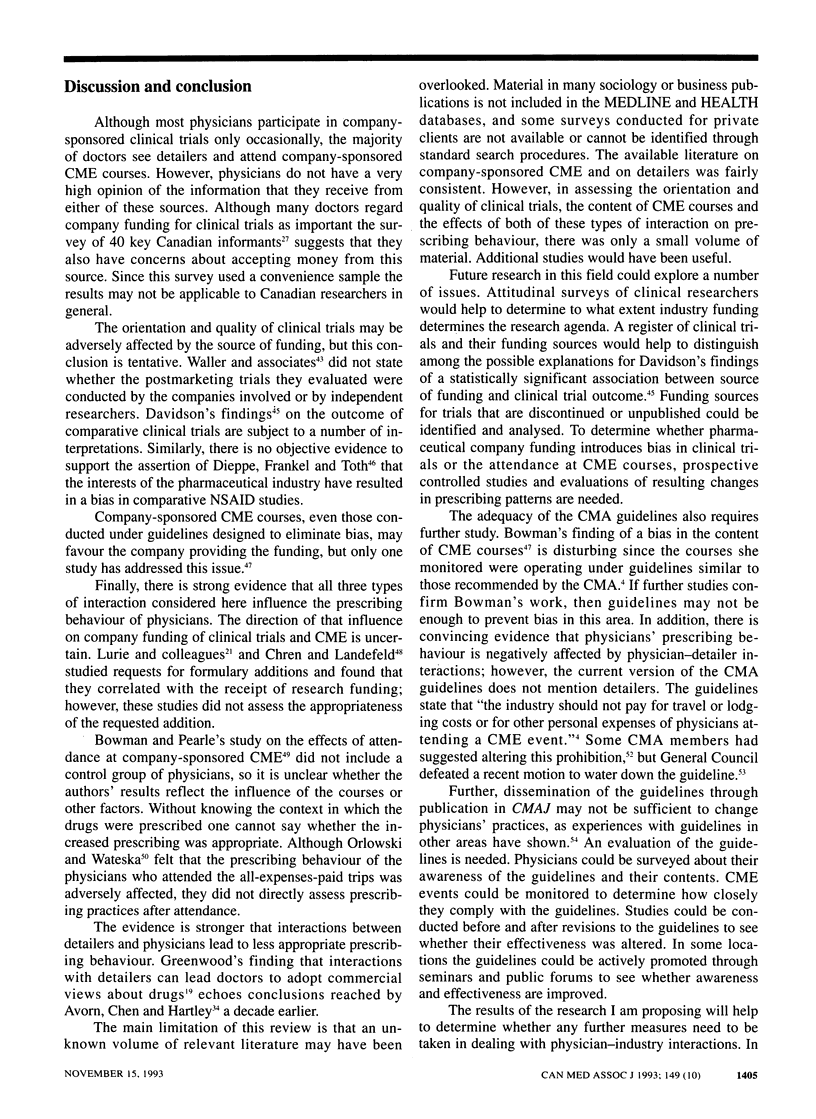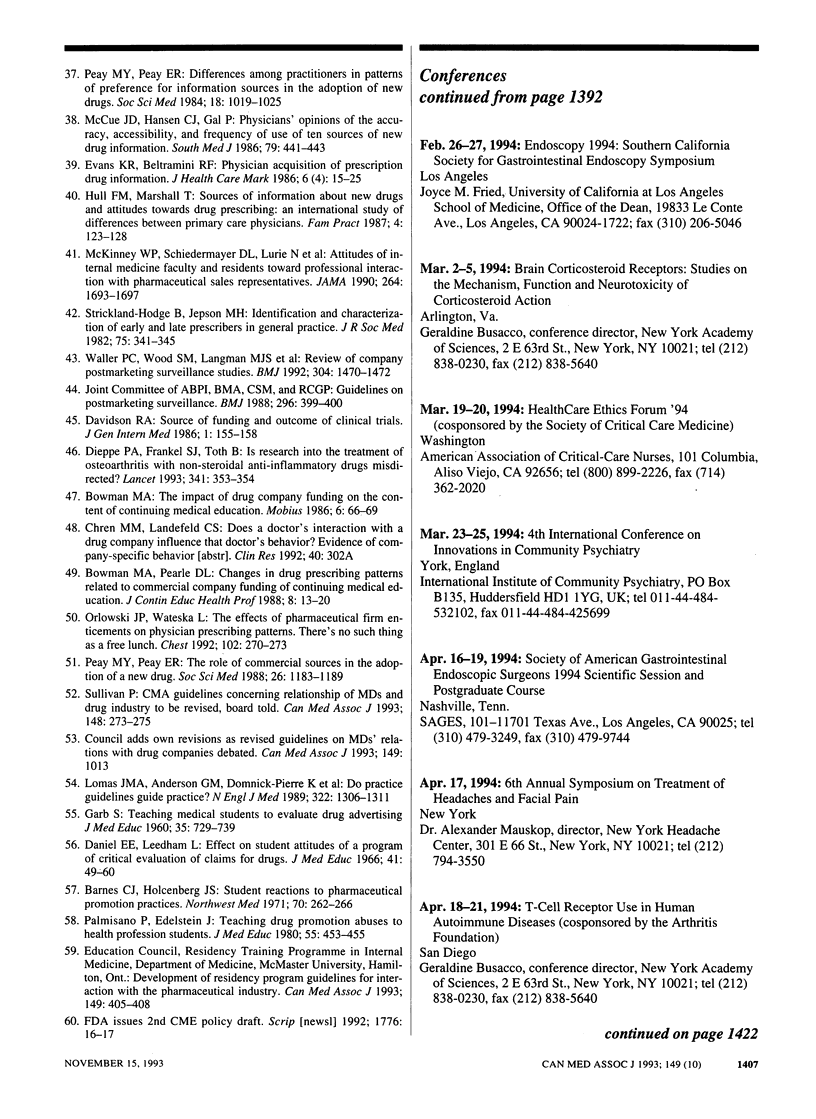Abstract
OBJECTIVE: To determine the effect of three types of interaction between physicians and the pharmaceutical industry--company-funded clinical trials, company-sponsored continuing medical education (CME) and information for physicians supplied by pharmaceutical detailers--on orientation and quality of clinical trials, content of CME courses and physicians' prescribing behaviour. DATA SOURCES: MEDLINE and HEALTH searches for English-language articles published from 1978 to 1993, supplemented by material from the author's personal collection. STUDY SELECTION: A total of 227 papers from the MEDLINE and HEALTH searches and about 2000 items from the author's library were initially reviewed. The following selection criteria were used: studies conducted in Australia, Canada, New Zealand, Britain and the United States; studies conducted after 1977; quantitative surveys containing details of the survey methods; studies on the orientation and quality of company-funded clinical trials and on the content of CME courses giving explicit criteria used in the evaluation; and reports on the outcome of interactions stating how the outcomes were assessed. Thirty-six studies met these criteria. DATA EXTRACTION: Information was extracted on five topics: physicians' attitudes toward drug industry interactions, frequency with which physicians participate in the interactions, orientation and quality of company-funded clinical trials, content of company-sponsored CME courses and changes in physicians' prescribing behaviour as a result of an interaction. DATA SYNTHESIS: Although most physicians participate only occasionally in company-sponsored clinical trials, most see detailers and attend company-sponsored CME courses. However, physicians do not have a very high opinion of the information from detailers or of company-sponsored CME events. Many doctors regard pharmaceutical companies as an important source of funding for clinical trials, but they also have concerns about accepting money from this source. Company funding of clinical trials may affect the quality of the trials and the types of research that physicians undertake. Company-sponsored CME courses may have a commercial bias even if conducted under guidelines designed to ensure the independence of the event. All three types of interactions affect physicians' prescribing behaviour and, in the case of obtaining information from detailers, physicians' prescribing practices are less appropriate as a result of the interaction. CONCLUSIONS: Physicians are affected by their interactions with the pharmaceutical industry. Further research needs to be done in most cases to determine whether such interactions lead to more or less appropriate prescribing practices. The CMA's guidelines on this topic should be evaluated to see whether they are effective in controlling physician-industry interactions. Further measures may be necessary if the guidelines fail to prevent negative effects on prescribing practices.
Full text
PDF






Selected References
These references are in PubMed. This may not be the complete list of references from this article.
- Arkinstall W. W. Physicians and pharmaceutical companies. CMAJ. 1992 Feb 1;146(3):327–332. [PMC free article] [PubMed] [Google Scholar]
- Barnes C. J., Holcenberg J. S. Student reactions to pharmaceutical promotion practices. Northwest Med. 1971 Apr;70(4):262–266. [PubMed] [Google Scholar]
- Bower A. D., Burkett G. L. Family physicians and generic drugs: a study of recognition, information sources, prescribing attitudes, and practices. J Fam Pract. 1987 Jun;24(6):612–616. [PubMed] [Google Scholar]
- Bowman M. A., Pearle D. L. Changes in drug prescribing patterns related to commercial company funding of continuing medical education. J Contin Educ Health Prof. 1988;8(1):13–20. doi: 10.1002/chp.4750080104. [DOI] [PubMed] [Google Scholar]
- Daniel E. E., Leedham L. Effect on student attitudes of a program of critical evaluation of claims for drugs. J Med Educ. 1966 Jan;41(1):49–60. doi: 10.1097/00001888-196601000-00006. [DOI] [PubMed] [Google Scholar]
- Davidson R. A. Source of funding and outcome of clinical trials. J Gen Intern Med. 1986 May-Jun;1(3):155–158. doi: 10.1007/BF02602327. [DOI] [PubMed] [Google Scholar]
- Dieppe P. A., Frankel S. J., Toth B. Is research into the treatment of osteoarthritis with non-steroidal anti-inflammatory drugs misdirected? Lancet. 1993 Feb 6;341(8841):353–354. doi: 10.1016/0140-6736(93)90147-9. [DOI] [PubMed] [Google Scholar]
- Evans K. R., Beltramini R. F. Physician acquisition of prescription drug information. J Health Care Mark. 1986 Dec;6(4):15–25. [PubMed] [Google Scholar]
- GARB S. Teaching medical students to evaluate drug advertising. J Med Educ. 1960 Aug;35:729–739. [PubMed] [Google Scholar]
- Gambrill J., Bridges-Webb C. Use of sources of therapeutic and prescribing information by general practitioners. Aust Fam Physician. 1980 Jul;9(7):482–484. [PubMed] [Google Scholar]
- Goldfinger S. E. A matter of influence. N Engl J Med. 1987 May 28;316(22):1408–1409. doi: 10.1056/NEJM198705283162211. [DOI] [PubMed] [Google Scholar]
- Hatton R. C., Doering P. L., Frias J. L. Physicians' sources of information about teratogenic effects of drugs. Drug Inf J. 1982 Jul-Sep;16(3):148–153. doi: 10.1177/009286158201600309. [DOI] [PubMed] [Google Scholar]
- Hayes T. M., Allery L. A., Harding K. G., Owen P. A. Continuing education for general practice and the role of the pharmaceutical industry. Br J Gen Pract. 1990 Dec;40(341):510–512. [PMC free article] [PubMed] [Google Scholar]
- Hull F. M., Marshall T. Sources of information about new drugs and attitudes towards drug prescribing: an international study of differences between primary care physicians. Fam Pract. 1987 Jun;4(2):123–128. doi: 10.1093/fampra/4.2.123. [DOI] [PubMed] [Google Scholar]
- Katz R. A. Unhook me. J Am Acad Dermatol. 1987 Nov;17(5 Pt 1):865–866. doi: 10.1016/s0190-9622(87)80305-5. [DOI] [PubMed] [Google Scholar]
- Kunin C. M. Clinical investigators and the pharmaceutical industry. Ann Intern Med. 1978 Nov;89(5 Pt 2 Suppl):842–845. doi: 10.7326/0003-4819-89-5-842. [DOI] [PubMed] [Google Scholar]
- Lomas J., Anderson G. M., Domnick-Pierre K., Vayda E., Enkin M. W., Hannah W. J. Do practice guidelines guide practice? The effect of a consensus statement on the practice of physicians. N Engl J Med. 1989 Nov 9;321(19):1306–1311. doi: 10.1056/NEJM198911093211906. [DOI] [PubMed] [Google Scholar]
- Lurie N., Rich E. C., Simpson D. E., Meyer J., Schiedermayer D. L., Goodman J. L., McKinney W. P. Pharmaceutical representatives in academic medical centers: interaction with faculty and housestaff. J Gen Intern Med. 1990 May-Jun;5(3):240–243. doi: 10.1007/BF02600542. [DOI] [PubMed] [Google Scholar]
- Manning P. R., Denson T. A. How internists learned about cimetidine. Ann Intern Med. 1980 May;92(5):690–692. doi: 10.7326/0003-4819-92-5-690. [DOI] [PubMed] [Google Scholar]
- McCue J. D., Hansen C. J., Gal P. Physicians' opinions of the accuracy, accessibility, and frequency of use of ten sources of new drug information. South Med J. 1986 Apr;79(4):441–443. doi: 10.1097/00007611-198604000-00013. [DOI] [PubMed] [Google Scholar]
- McKinney W. P., Schiedermayer D. L., Lurie N., Simpson D. E., Goodman J. L., Rich E. C. Attitudes of internal medicine faculty and residents toward professional interaction with pharmaceutical sales representatives. JAMA. 1990 Oct 3;264(13):1693–1697. [PubMed] [Google Scholar]
- Nelson J. C. A piece of my mind. A snorkel, a 5-iron, and a pen. JAMA. 1990 Aug 8;264(6):742–742. doi: 10.1001/jama.264.6.742. [DOI] [PubMed] [Google Scholar]
- Orlowski J. P., Wateska L. The effects of pharmaceutical firm enticements on physician prescribing patterns. There's no such thing as a free lunch. Chest. 1992 Jul;102(1):270–273. doi: 10.1378/chest.102.1.270. [DOI] [PubMed] [Google Scholar]
- Palmisano P., Edelstein J. Teaching drug promotion abuses to health profession students. J Med Educ. 1980 May;55(5):453–455. doi: 10.1097/00001888-198005000-00013. [DOI] [PubMed] [Google Scholar]
- Peay M. Y., Peay E. R. Differences among practitioners in patterns of preference for information sources in the adoption of new drugs. Soc Sci Med. 1984;18(12):1019–1025. doi: 10.1016/0277-9536(84)90160-6. [DOI] [PubMed] [Google Scholar]
- Peay M. Y., Peay E. R. Patterns of preference for information sources in the adoption of new drugs by specialists. Soc Sci Med. 1990;31(4):467–476. doi: 10.1016/0277-9536(90)90042-q. [DOI] [PubMed] [Google Scholar]
- Peay M. Y., Peay E. R. The role of commercial sources in the adoption of a new drug. Soc Sci Med. 1988;26(12):1183–1189. doi: 10.1016/0277-9536(88)90149-9. [DOI] [PubMed] [Google Scholar]
- Shin J. H., Haynes R. B., Johnston M. E. Effect of problem-based, self-directed undergraduate education on life-long learning. CMAJ. 1993 Mar 15;148(6):969–976. [PMC free article] [PubMed] [Google Scholar]
- Strickland-Hodge B., Jepson M. H. Identification and characterization of early and late prescribers in general practice. J R Soc Med. 1982 May;75(5):341–345. doi: 10.1177/014107688207500510. [DOI] [PMC free article] [PubMed] [Google Scholar]
- Strickland-Hodge B., Jeqson M. H. Usage of information sources by general practitioners. J R Soc Med. 1980 Dec;73(12):857–862. doi: 10.1177/014107688007301208. [DOI] [PMC free article] [PubMed] [Google Scholar]
- Sullivan Patrick. CMA guidelines concerning relationship of MDs and drug industry to be revised, board told. CMAJ. 1993 Jan 15;148(2):273–275. [PMC free article] [PubMed] [Google Scholar]
- Taylor R. J., Bond C. M. Change in the established prescribing habits of general practitioners: an analysis of initial prescriptions in general practice. Br J Gen Pract. 1991 Jun;41(347):244–248. [PMC free article] [PubMed] [Google Scholar]
- Thompson W. G. The ethics of physician-pharmaceutical company relationships. CMAJ. 1988 Nov 1;139(9):835–836. [PMC free article] [PubMed] [Google Scholar]
- Waller P. C., Wood S. M., Langman M. J., Breckenridge A. M., Rawlins M. D. Review of company postmarketing surveillance studies. BMJ. 1992 Jun 6;304(6840):1470–1472. doi: 10.1136/bmj.304.6840.1470. [DOI] [PMC free article] [PubMed] [Google Scholar]


